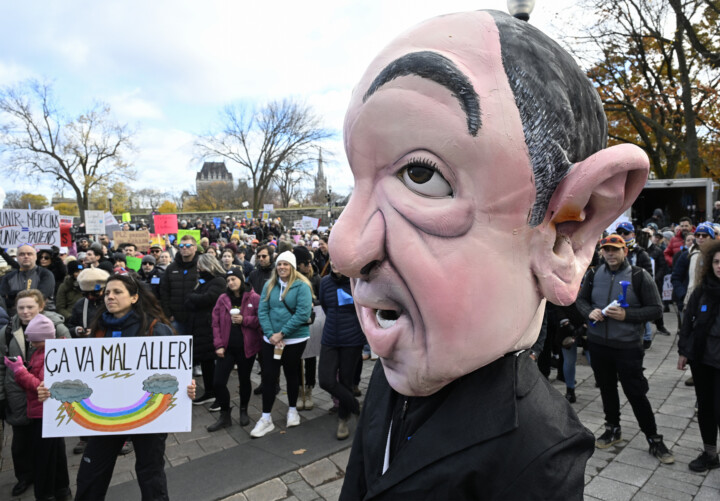‘The president is clearly frustrated’: What’s really behind Trump’s latest tariff tirade?
Rudyard Griffiths and Sean Speer discuss the rapidly deteriorating trade relationship between Canada and the United States following President Trump’s angry response to Ontario’s Reagan ad. They examine Trump’s additional 10 percent tariff threats on Canadian goods, his refusal to meet with Prime Minister Mark Carney, and whether these reactions signal deeper frustrations with Canada’s negotiating positions on issues like supply management and internet regulation.
They explore Canada’s weakening leverage as the U.S. appears to reach trade deals with other major economies, and how an upcoming Supreme Court ruling on Trump’s emergency trade powers could fundamentally reshape both the bilateral trade relationship and U.S. constitutional limits on presidential authority.
You can listen to this episode on Amazon, Apple, and Spotify.
Program Summary
This is an automated summary. Please check against delivery.
Tensions between the United States and Canada have escalated dramatically, casting a pall over trade negotiations and raising fundamental questions about the future of the bilateral relationship. The immediate catalyst appears to have been a political advertisement that enraged the American president, leading him to break off talks, threaten an additional 10% tariff on Canadian goods, and publicly declare that he would not be meeting with the Canadian Prime Minister for a long time. However, a closer examination suggests this flashpoint is symptomatic of deeper, long-simmering grievances.
The US administration’s frustration seems to extend beyond a single advertisement. Reports indicate that American officials have grown weary of what they perceive as stalling tactics from Canadian negotiators or a vision for the trade relationship that is fundamentally misaligned with US priorities. The American focus is squarely on generating revenue from tariffs and creating production incentives, objectives that Canadian proposals may not adequately address. Key irritants for the US include Canada’s staunch defence of supply management in agriculture, as well as its positions on internet regulation and cultural protection rules known as “can con.” Where previous US administrations may have shown magnanimity on these issues, the current one appears to have no such inclination, demanding their resolution and presenting the Canadian government with profoundly difficult political choices.
The American president’s approach has been marked by impulsiveness. The threat of a 10% tariff was announced without details on what goods would be affected or when it would be implemented, highlighting a lack of sophistication that stands in stark contrast to the deep, analytical dive one might expect from a US administration on complex economic matters. This personalisation of the dispute is particularly jarring given that, until recently, the relationship between the two leaders seemed positive, and Canadian officials had been publicly optimistic about an imminent sectoral deal. The sudden whiplash has left observers and officials alike perplexed.
The geopolitical chessboard further complicates Canada’s position. The United States appears to be on the cusp of finalising trade arrangements with other major economies, including Japan, Europe, and potentially China. A deal with China, in particular, would represent a notable shift, as it would seem to affirm the very orthodoxy on trade with Beijing that the president had long challenged. For Canada, this growing list of US agreements is alarming. As the US secures deals elsewhere, Canada risks becoming the “odd man out,” its leverage diminishing precipitously. In a world where the US has settled its other major trade files, Canada may find itself forced to accept a less favourable deal simply to avoid total isolation. This raises the troubling question of whether Canadian strategy has been misguided, prioritising delay over securing a front-of-the-line position that might have yielded better terms.
A pivotal known unknown looms on the horizon: a November 5th hearing at the US Supreme Court. The case challenges the very foundation of the president’s emergency trade powers, arguing that his widespread use of tariffs exceeds his legal authority. A ruling against the administration could upend the entire landscape. If the court deems these powers illegal, it could invalidate the tariffs and any trade deals predicated upon them. In such a scenario, Canada, by not having formalised a new agreement based on potentially illegal fiat, could unexpectedly find itself in an advantageous position.
However, the judicial outcome is far from certain and carries immense constitutional weight. This is not merely a technical trade case; it is a fundamental test of the limits of executive power. The ruling may serve as a preview of how the court will handle other instances where the president pushes against institutional guardrails. There is a palpable concern that the court, despite the jurisprudence, could deliver a decision in the president’s favour, which would simultaneously empower his trade agenda and signal an alarming weakening of checks and balances.
This concern is amplified by the current political tempo in Washington. A series of extra-judicial actions—from unilateral domestic projects to controversial military operations abroad—combined with a paralysed Congress, creates an atmosphere where the president appears to be testing the boundaries of his authority with few constraints. The question is whether the Supreme Court will be intimidated by this crescendo or whether it will, in the absence of other functioning institutions, draw a definitive red line. The decision will therefore be consequential not only for the fate of Canada-US trade but for the very future of the American republic. The situation remains fluid, and all parties are watching closely as these profound political, economic, and legal dynamics converge.
Beyond the immediate ad, what deeper US grievances fuel Trump's tariff threats against Canada?
How does the US securing trade deals with other nations impact Canada's negotiating leverage?
What are the potential implications of the upcoming Supreme Court ruling on Trump's emergency trade powers for Canada-US relations?




Comments (0)